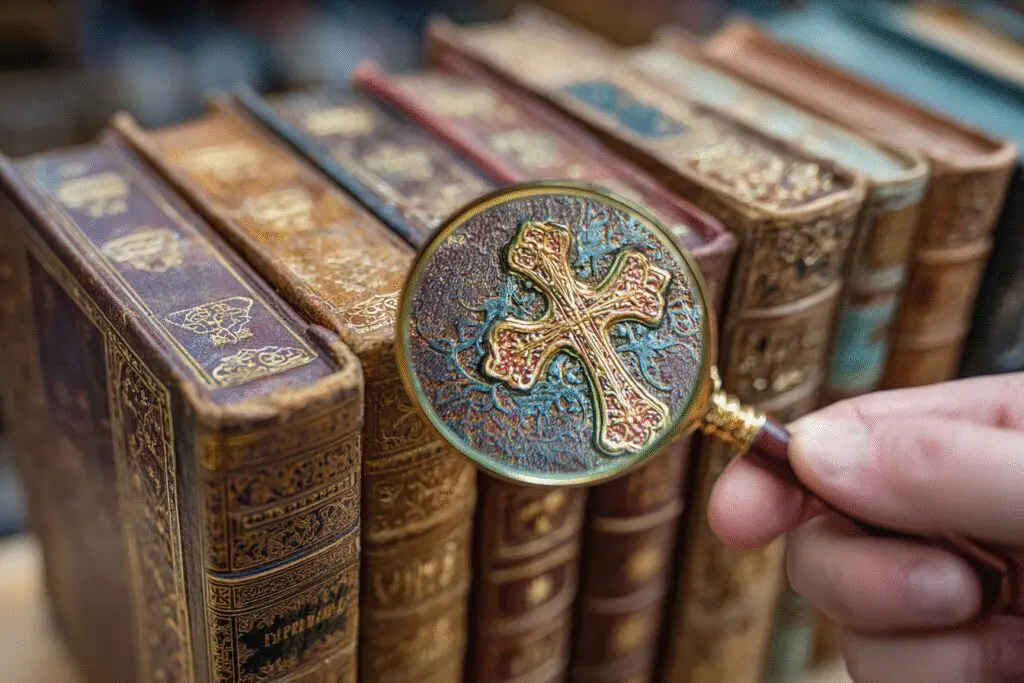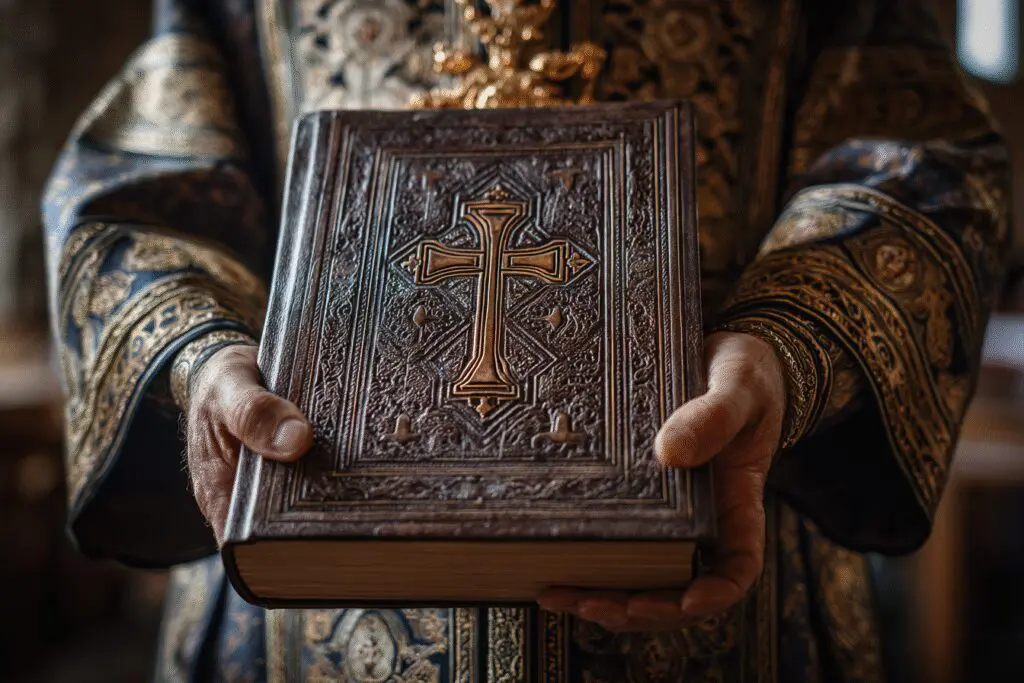I remember the first time I walked into an Orthodox bookstore. I was looking for a Bible, something familiar, but the one they handed me felt… heavier. Thicker. Flipping through the table of contents, I saw names of books I’d only vaguely heard of, like Tobit and Judith. It was a moment of genuine confusion and curiosity. I thought, “Isn’t the Bible… just the Bible?” That simple question sent me down a fascinating path of discovery. So, if you’re asking, What Bible does the Orthodox Church use?, you’re asking a fantastic and important question that gets to the very heart of ancient Christian history.
The short and direct answer is this: The Orthodox Church uses a Bible that is based on the Septuagint for its Old Testament. This version is more ancient than the text used for most Protestant Bibles and includes several additional books. The New Testament is the same 27 books you’d find in any Christian Bible.
But that simple answer barely scratches the surface. The story behind the Orthodox Bible is a story about the early Church, about how Scripture was understood by the Apostles themselves, and how that tradition has been carefully preserved for two millennia. It’s a journey worth taking.
More in Bible Category
Why Are There So Many Bible Translations
Which Version of the Bible Is Easiest to Understand
Which Bible Version Is the Best
Key Takeaways
- The Old Testament is Different: The Orthodox Old Testament is based on the Greek Septuagint, the translation used by the Apostles. The Protestant Old Testament is based on the Hebrew Masoretic Text, which is a later text.
- More Books Included: The Orthodox Bible includes books that Protestants call the “Apocrypha.” In the Orthodox tradition, these are called Anagignoskomena, or “Worthy of Reading,” and are considered part of the canon. Examples include Tobit, Judith, Wisdom of Solomon, and 1-4 Maccabees.
- The New Testament is the Same: The Orthodox Church accepts the same 27 books of the New Testament as Roman Catholics and Protestants.
- The “Official” Translation: The most popular and comprehensive English version is the Orthodox Study Bible, which uses a fresh translation of the Septuagint for the Old Testament.
Why Isn’t the Orthodox Bible the Same as Other Christian Bibles?
This is where the history really comes alive. It’s not that someone decided to add books; rather, the question is why, centuries later, other traditions decided to remove them. The difference boils down to which ancient manuscript of the Old Testament you consider the most authoritative.
A Quick Look at the History of the Old Testament
Long before Jesus was born in Bethlehem, the Hebrew Scriptures (what we call the Old Testament) existed. Around the 3rd century B.C., a monumental translation project began in Alexandria, Egypt. The goal was to translate the Hebrew Scriptures into Greek, which was the common language of the Mediterranean world at the time.
This translation is called the Septuagint (often abbreviated as LXX), named after the legend that 70 (or 72) scholars worked independently and miraculously produced identical translations. Whether the legend is true or not, the result was a Greek version of the Old Testament that became the standard Scripture for Jews living outside of Palestine and, crucially, for the first Christians.
What is the Septuagint and Why is it So Important?
The importance of the Septuagint for Christians truly cannot be overstated. When you read the New Testament, and you see the Apostles or Jesus Himself quoting the Old Testament, they are almost always quoting from the Septuagint.
Think about that for a moment. The Bible of the early Church—the one St. Paul read, the one St. Peter quoted on Pentecost—was the Septuagint. It was the lens through which they understood the prophecies about the Messiah. This Greek version included the books that are now missing from Protestant Bibles, and the early Christians accepted them as part of their sacred writings without any real controversy. For the Orthodox Church, continuing to use the Septuagint is a matter of faithfulness to the apostolic tradition. It’s about reading the same Old Testament that the first followers of Christ read.
How Did the Protestant Bible Come to Be Different?
The change came much, much later, during the Protestant Reformation in the 16th century. When reformers like Martin Luther were translating the Bible into the common languages, they made a pivotal decision. They chose to base their Old Testament translation not on the Septuagint, but on the Masoretic Text.
The Masoretic Text is a Hebrew version of the Old Testament that was compiled by Jewish scholars between the 7th and 10th centuries A.D. Because it was in Hebrew, the reformers felt it was more “original” or authentic. In doing so, they adopted the Jewish canon of the day, which had been finalized long after the time of Christ and did not include the “extra” books found in the Septuagint.
So, from an Orthodox perspective, the question isn’t “Why did you add books?” but rather “Why were books that were part of the Christian Scripture for 1,500 years removed?”
So, What Books Are Actually in the Orthodox Old Testament?
Seeing the full list of books can be really eye-opening. It gives you a sense of the richness and depth of the tradition. The additional books are woven into the fabric of the Old Testament, not just tacked on at the end.
The Books You Won’t Find in a Protestant Bible
These texts are known in the Orthodox Church as the Anagignoskomena (pronounced ah-nah-ghig-noh-SKOH-meh-nah). This Greek word means “things that are worthy to be read.” They are considered canonical Scripture and are read in church services.
Here is a list of the books included in the Orthodox Old Testament that are not in the Protestant 66-book canon:
- 1, 2, and 3 Esdras (Ezra and Nehemiah are sometimes counted as 1 and 2 Esdras in other traditions)
- Tobit
- Judith
- Wisdom of Solomon
- Wisdom of Sirach (also called Ecclesiasticus)
- Baruch
- Letter of Jeremiah
- 1, 2, 3, and 4 Maccabees (Protestant Apocrypha usually only includes 1 and 2)
- Psalm 151
- Prayer of Manasseh
Additionally, the books of Daniel and Esther are longer in the Orthodox Bible, containing sections that are not in the Masoretic Text, such as the story of Susanna and the Dragon in Daniel.
Are These Books Considered “Apocrypha”? The Orthodox Perspective
The word “Apocrypha” means “hidden things,” and in Protestant circles, it carries a connotation of being less authoritative or even spurious. The Orthodox Church does not use this term for these books. They are simply part of the Old Testament, full stop.
Calling them Anagignoskomena acknowledges their place in the canon and their value for the life of the Church. These books contain profound teachings on wisdom, prayer, almsgiving, and the sovereignty of God. The stories of the Maccabean martyrs, for instance, are a powerful testament to faithfulness under persecution that deeply informs Orthodox spirituality.
Does the Orthodox Church Have a Different New Testament Too?
This is a very common and logical follow-up question. Given the differences in the Old Testament, it’s natural to wonder if the New Testament is also different.
The 27 Books We All Share
The answer here is refreshingly simple: No. The Orthodox Church accepts the exact same 27 books of the New Testament that are recognized by Roman Catholics and Protestants. From the Gospel of Matthew to the Book of Revelation, the list is identical.
This universal agreement on the New Testament is a beautiful testament to the work of the Holy Spirit in the early Church. By the 4th century, a consensus had been firmly established about which apostolic writings were to be considered inspired Scripture, and that consensus has remained firm across all major branches of Christianity.
What About the Book of Revelation?
It’s historically interesting to note that for a period in the early Church, there was some hesitation in the East about the Book of Revelation. This wasn’t due to doubts about its truthfulness, but rather concerns about it being misinterpreted by fringe groups.
For this reason, the Book of Revelation is the only New Testament book that is not read as part of the regular cycle of liturgical readings in the Orthodox Church. However, it is fully accepted as canonical, inspired Scripture, and Orthodox Christians are encouraged to read and study it privately. I personally find its message of Christ’s ultimate victory to be a source of incredible hope.
What is the Official English Translation for the Orthodox Church?
Alright, let’s get practical. If you want to go out and buy an Orthodox Bible, what should you look for? This can be a little confusing because, unlike some other denominations, the Orthodox Church doesn’t have a single, universally mandated “official” translation in English.
Is There One Single “Official” Version?
The Orthodox Church is a communion of self-governing churches (Greek, Russian, Antiochian, etc.). This decentralized structure means that there isn’t one body with the authority to declare a single English version as the only one to be used.
The “official” text of the Old Testament remains the Greek Septuagint, and the “official” text of the New Testament is the Greek Koine text from which all modern translations are derived. Different jurisdictions and even individual parishes may have their preferred translations for worship and study.
The Orthodox Study Bible: A Modern Go-To Resource
Despite the lack of a single mandated version, there is one resource that has become the undisputed standard for English-speaking Orthodox Christians: The Orthodox Study Bible.
I remember when I finally got my own copy. It wasn’t just about having the extra books; it was about the notes. For the first time, I was reading the Scriptures with commentary from the ancient Church Fathers. It was like having a conversation with saints who lived 1,500 years ago, and it completely changed how I understood the Bible.
The Orthodox Study Bible (OSB) is unique for a few key reasons:
- A Fresh Old Testament Translation: The Old Testament in the OSB is a brand new translation of the Septuagint, called the St. Athanasius Academy Septuagint. It was specifically created for this Bible.
- The New King James Version: For the New Testament, the OSB uses the New King James Version (NKJV), chosen for its accuracy and its basis in the traditional Greek text (the Textus Receptus).
- Patristic Commentary: The notes and articles are all drawn from the writings of the early Church Fathers, providing an authentic window into how the first Christians interpreted Scripture.
- Liturgical Guides: It includes lectionary readings, morning and evening prayers, and icons, integrating the Bible into the life of worship.
For anyone in the USA looking to explore the Orthodox understanding of Scripture, the Orthodox Study Bible is, without a doubt, the best place to start.
Other Recommended Translations You Might Encounter
While the OSB is the most popular, there are other good English translations you might see used in Orthodox settings. The Eastern Orthodox Bible (EOB) is an ongoing translation project that offers a modern language version of the full Orthodox canon. Some older parishes might also use the King James Version with a separate Apocrypha, but this is less common today. For a deeper academic dive, scholars often turn to translations like A New English Translation of the Septuagint (available from academic sources like Yale), but for personal devotion and study, the OSB remains the top recommendation.
How Does the Orthodox Church Actually Use the Bible in Worship?
This might be the most important part of the whole discussion. For the Orthodox, the Bible isn’t just a book of history or a manual for morality that you read at home. It is a living, active presence in the heart of the Church’s worship. The Scripture is truly alive.
The Bible Isn’t Just a Book, It’s Part of the Liturgy
If you attend an Orthodox service, like the Divine Liturgy, you will be immersed in Scripture. Much of the service is composed of direct quotes from the Psalms and other books. The hymns, the prayers, the litanies—they are all saturated with biblical language and imagery.
We don’t just read the Bible; we pray it, we sing it, we experience it. The Bible is seen as a book of the Church, for the Church. It was compiled, preserved, and canonized by the Church, and it finds its ultimate meaning and interpretation within the communal life of the Church’s worship.
The Central Role of the Gospels in Services
You can see the reverence for the Scripture in how the physical Gospel book is treated. It is enthroned on the altar, carried in procession with candles and incense, and the priest or deacon kisses it before reading from it.
During the Divine Liturgy, the reading of the Gospel is the pinnacle of the Liturgy of the Word. Everyone stands in attention as the words of Christ are proclaimed. It is understood not as a history lesson, but as Christ Himself speaking to His people right here and now. This high reverence underscores that the Bible is the inspired Word of God.
How Orthodox Christians Read Scripture Personally
Of course, Orthodox Christians are also encouraged to read the Bible at home. But this private reading is never fully disconnected from the life of the Church. We are taught to read Scripture with a prayerful heart, asking the Holy Spirit for illumination.
We also read it with the “mind of the Church,” meaning we rely on the interpretations of the Church Fathers and the hymns of the services to guide our understanding. This protects us from falling into misinterpretation and keeps our personal journey grounded in the ancient, apostolic faith. It’s a team effort, a family conversation that has been going on for 2,000 years.
Why Does This Difference in Bibles Matter for a Christian’s Faith?
At the end of the day, is this just a historical curiosity? Does it really matter that our Bibles have different tables of contents? I believe it matters immensely. The Scriptures we read shape the way we view God, ourselves, and the world.
How the Fuller Old Testament Shapes Orthodox Theology
The additional books in the Orthodox Old Testament are not silent. They speak, and their voice reinforces key aspects of Orthodox faith and practice.
For example, the book of 2 Maccabees includes a clear reference to praying for the dead (2 Maccabees 12:44-45), a practice that has been part of the Orthodox tradition since the beginning. The Wisdom of Solomon contains beautiful theology about the nature of God’s wisdom that complements the book of Proverbs. The story of Tobit is a touching narrative about family, angelic help, and the importance of charity. These texts add color, texture, and depth to our understanding of God’s relationship with His people.
A Bridge to the Early Church
For me, the most powerful reason this matters is connection. Reading the Septuagint is reading the Old Testament of the Apostles. It connects me to the first generation of Christians in a tangible way. It assures me that the faith I practice today is the same faith that was “once for all delivered to the saints” (Jude 1:3).
It’s a firm foundation. In a world of shifting ideas, holding the same Bible as the early martyrs and the great saints of the Church is a profound comfort and a powerful anchor for the soul. It reminds us that our faith is not something new, but something ancient, timeless, and true.
The journey into understanding the Orthodox Bible is a journey into the heart of the early Church. It’s a discovery that the Bible is bigger, richer, and more deeply connected to the life of worship than we might have imagined. It’s a beautiful heritage, preserved with love for all who are seeking the fullness of the Christian faith.
Frequently Asked Questions – What Bible Does the Orthodox Church Use

How do Orthodox Christians incorporate the Bible into their worship practices?
Orthodox Christians incorporate the Bible into worship through readings during the Divine Liturgy, handling the Gospel book with reverence, and through icons that visually depict Bible stories, helping the faithful see and hear the Word of God as part of their spiritual life.
Which Bible is most commonly used by English-speaking Orthodox Christians today?
The most commonly used Bible among English-speaking Orthodox Christians is the Orthodox Study Bible, which features the Septuagint translation of the Old Testament and the New King James Version for the New Testament.
What books are included in the Orthodox Old Testament but not in the Protestant version?
Books such as Tobit, Judith, the Wisdom of Solomon, the Wisdom of Jesus Son of Sirach, Baruch, the Letter of Jeremiah, 1-4 Maccabees, Psalm 151, and additional parts in Esther and Daniel are included in the Orthodox Old Testament but are absent in most Protestant Bibles.
How does the Orthodox Old Testament differ from Protestant and Catholic Bibles?
The Orthodox Old Testament is longer because it includes several books not found in Protestant Bibles, known as the Anagignoskomena, which Protestants often call the Apocrypha. Catholics refer to these books as deuterocanonical.
What is the primary Old Testament used in the Orthodox Church?
The Orthodox Church primarily uses the Septuagint, a Greek translation of the Hebrew Scriptures, as its Old Testament since it was the version used by early Christians and believed to be guided by the Holy Spirit.




